Blum W., Riegler W., Rolandi L. Particle Detection with Drift Chambers
Подождите немного. Документ загружается.

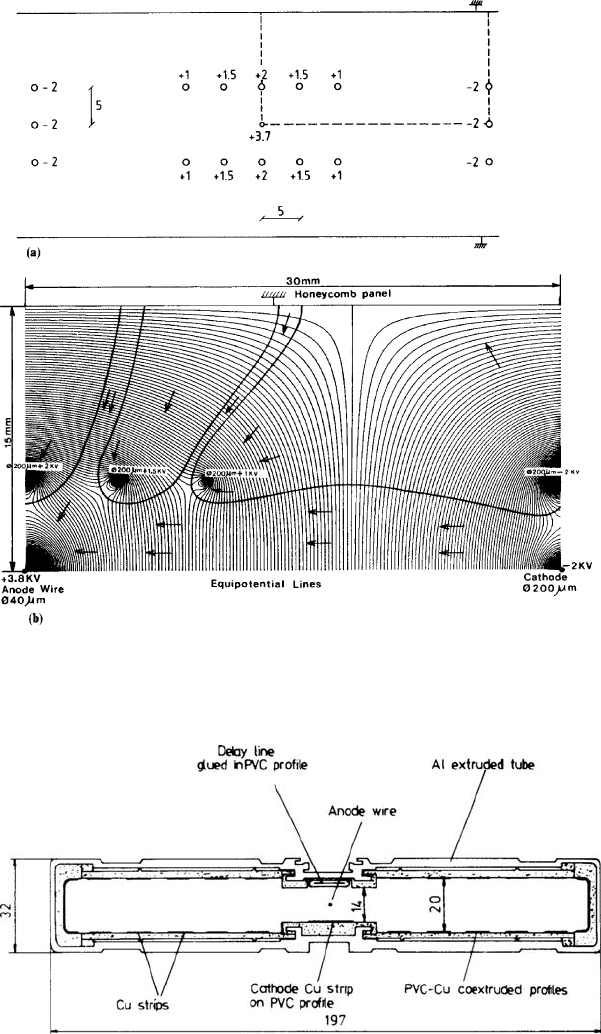
372 11 Existing Drift Chambers – An Overview
Fig. 11.6a,b A drift cell of the CDHS chambers. (a) sense wires (small circles)andfieldwires
(large circles) with their potentials in kV; some distances are also indicated in mm; (b) equipoten-
tial lines, delineating sensitive areas for one quarter of the drift cell, as indicated in (a)
Fig. 11.7 Cross section of a drift-chamber module of the DELPHI Muon Identifier; the delay line
is incorporated in the cathode
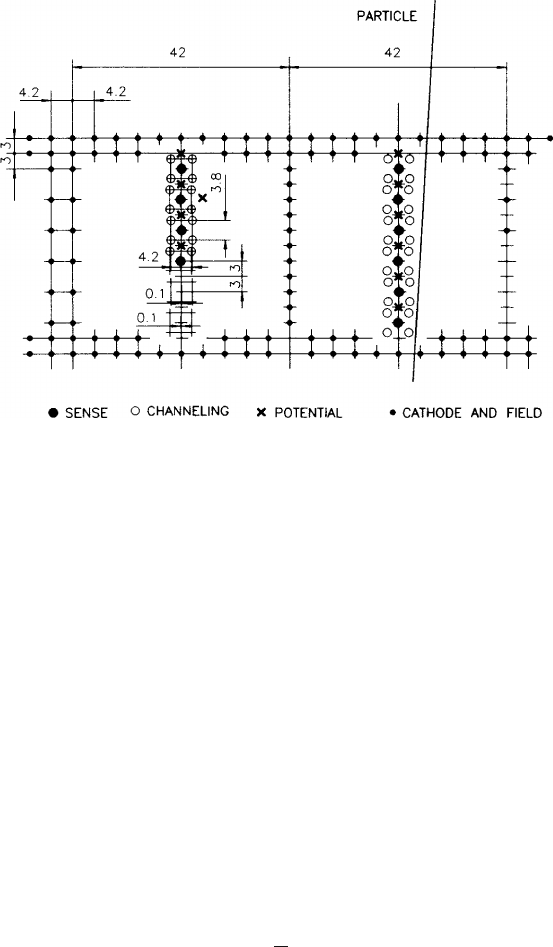
11.4 Planar Drift Chambers of Type 1 373
Fig. 11.8 A drift cell of the DC1 chambers in the HELIOS experiment; dimensions in mm
double-track separation. The solution adopted involves a slow gas which in turn
needed small drift cells in the high-multiplicity, high-rate environment. We see the
drift cell in Fig. 11.8. It must provide a very homogeneous field because the gas is
not saturated; therefore in each drift cell the eight sense wires are surrounded by a
large number of field wires. In an attempt to reduce the influence of the drift-time
variations, some of the field wires were given such potentials that only a fraction
of the ionization along the track was collected on the sense wires. The whole stack
consists of six chambers with three different wire orientations. The performance
figures reveal that the outstanding measuring accuracy of 60 μm per wire, reached
with the prototype, worsened and became 120 μm in the real experiment where the
presence of many tracks deteriorated the critical field conditions.
The muon chambers of the L3 experiment are the result of a colossal effort
to measure the momenta of fast muons with an accuracy of at least
δ
p
T
/p
2
T
=
4 ×10
−4
GeV/c
−1
, in cylindrical geometry. In the experiment, the radial space be-
tween 2.5 and 5.4 m was allocated to this task, inside a magnetic field of 0.5 T. The
principle of the solution is sketched in Fig. 11.9; one observes that for the optimal
measurement of momenta in the magnetic field, the chambers are concentrated at
the inner and outer edges, and in the middle of the radial space (cf. the discussion in
Sect. 8.2.6). Their local measuring accuracy is increased by sampling each track N
times, thus gaining a factor of 1
√
N over the accuracy of a single wire – provided,
the relative wire positions are sufficiently well known. For this purpose, the sense
wires have been pulled over optically flat edges and are supported in the middle in
a controlled fashion. We show in Fig. 11.10 the drift cell of the chamber type in the
middle; it has N = 24 sense wires, 0.9 cm apart and 5.5 m long. Under operating
conditions the Lorentz angle is 19
◦
.
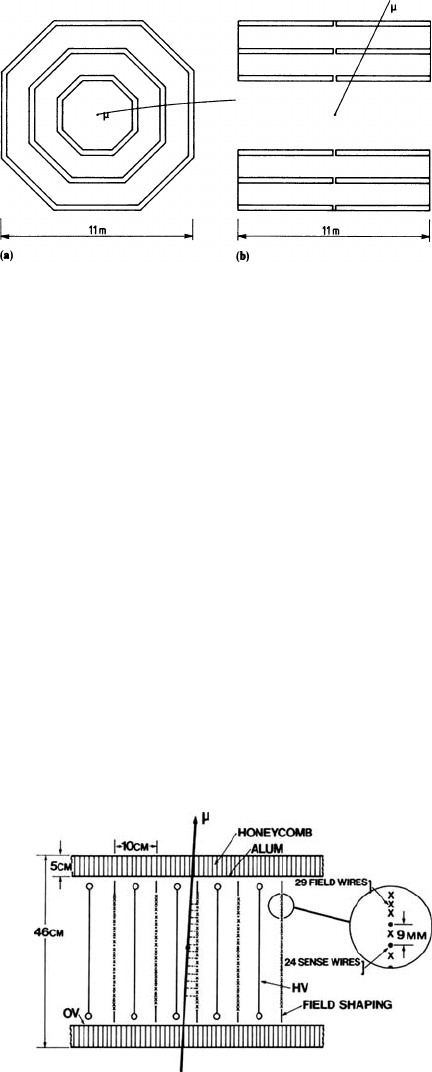
374 11 Existing Drift Chambers – An Overview
Fig. 11.9a,b Arrangement of
the muon chambers in the L3
experiment. (a) view along
the axis; (b) side view
In order to make full use of the local accuracy, the three chambers traversed by
a fast muon must be in well-known and constant relative positions. This has been
achieved to an accuracy of 30μm, or 10
−5
of the size of the mechanical structure.
This combination of size and positioning accuracy was unprecedented at the time in
high-energy physics experiments.
The disk-shaped forward tracking chambers for the H1 experiment are in our
collection on account of their circular symmetry and their radial sense wires. But
they are also interesting because, in addition to measuring tracks, they serve for the
detection of single photons created by transition radiators immediately upstream.
For this double function the gas was chosen to contain a sizeable fraction of xenon
with its short absorption length for soft X-rays.
The three-dimensional schematic drawing of Fig. 11.11 makes the 48 wedge-
shaped drift cells visible. Each one has at its centre the radial plane of the eight
radial sense wires, which are interspersed with field wires, and on both sides the
cathode planes. So at the outer radius the drift space is larger than at the inner one
in the ratio of these radii; and in order to maintain a uniform drift field in the cell,
the cathode is divided into axial strips on such radially increasing potentials that
the electric field is everywhere the same and orthogonal to the sense-wire plane.
Suitable field degraders close the volume of every cell. The drift-time coordinate
Fig. 11.10 One drift cell of a
middle muon chamber of the
L3 experiment
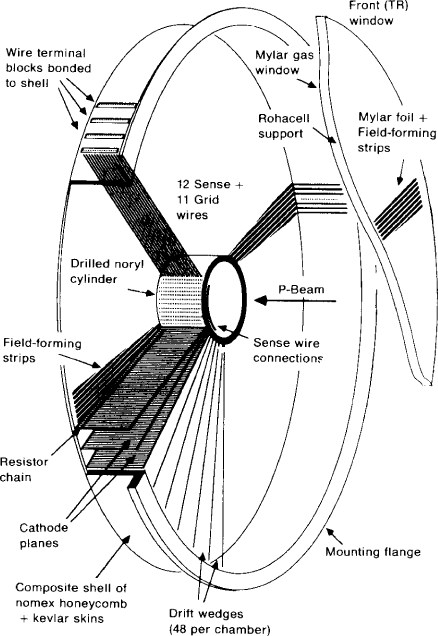
11.4 Planar Drift Chambers of Type 1 375
Fig. 11.11 Schematic blow-up of the radial-wire drift chamber of the H1 experiment
is in the azimuthal direction, thus appropriate for a measurement of the particle
momentum in the axial magnet. (The influence of the magnetic field on the drift
directions has been neglected here, cf. Sect. 11.3.2.) The radial track coordinate is
obtained by charge division on pairs of wires. Similar chambers had previously been
constructed for the CDF experiment at Fermilab.
11.4.3 Type 1 Chambers without Field-Shaping Electrodes
The drift field of a conventional drift chamber is established by conducting sur-
faces (field wires, metal strips etc.) at suitable potentials. But according to an idea
of Allison et al. [ALL 82a], the drift field can also be established by deposition
of electrostatic charge on the insulating surfaces that delimit the gas volume. They
showed that in a large flat plastic box one can get a very homogeneous field just with
one proportional wire in the middle and two small cathode strips along the parallel
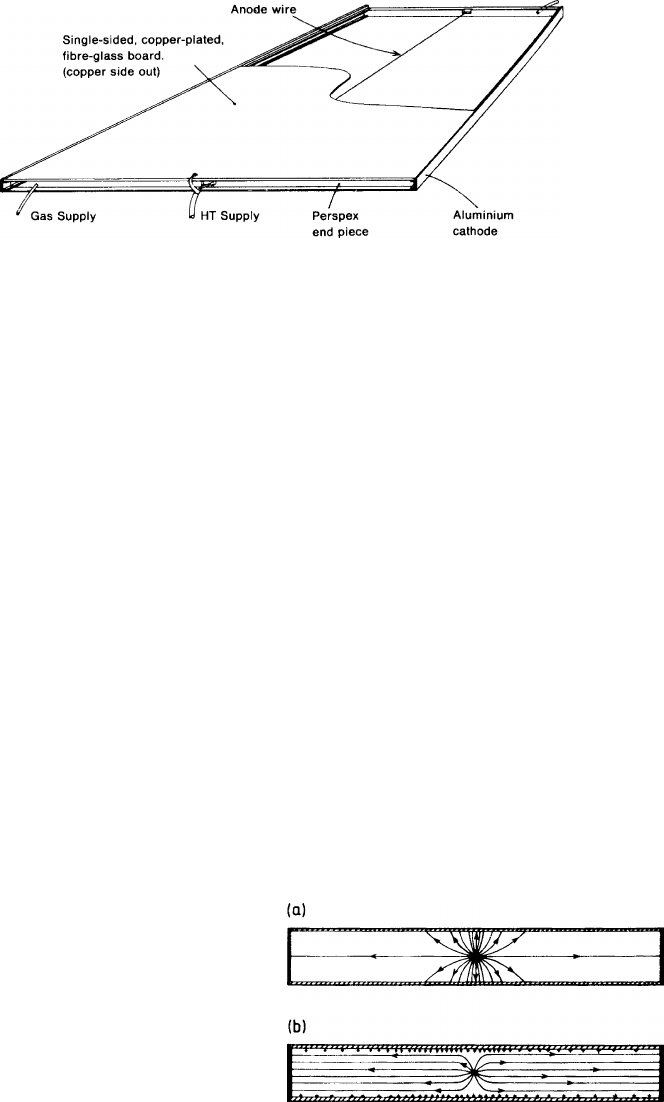
376 11 Existing Drift Chambers – An Overview
Fig. 11.12 A chamber without field-shaping electrodes
edges (Fig. 11.12). The deposition of charge is straightforward if the insulating sur-
faces are backed (on the outside) by grounded plates parallel to the surface. Looking
at Fig. 11.13a, the field lines are as indicated at the moment that HV is applied to
the sense wire. Any positive charge from the wire amplification will travel along the
field lines and will fall onto the insulator and stay there to subsequently change the
field configuration.
This process continues until there are no more field lines pointing at the insu-
lator, i.e. the ideal field configuration is reached (Fig. 11.13b). As long as there
is any charge amplification going on at the wire, the ideal field configuration will
automatically be reached. It should be noted that for a thin chamber, the charge
on the wire must finally be equal to the charge on the insulating surface. This im-
plies that the gas amplification factor, which is determined by the amount of charge
on the wire, cannot be altered without changing the drift field in the volume. The
problematic side of this method is in the stability of the field. Although the positive
charges are easily brought into place, they are not so easily removed following small
fluctuations – these may be due to local discharges, bursts of particles, deposits on
the wire, etc., and are probably unavoidable. Allison et al. consider insulators with
a non-zero conductivity; these would create a dynamic equilibrium, which would
become a function of the rate of charge deposition.
On the other hand the new principle makes it easy to construct very simple drift
chambers. Franz and Grupen [FRA 82] have described the properties of a flat, round
chamber (1.4 cm × 50 cm diam) with only one short (1.4 cm) wire in the centre.
Fig. 11.13a,b Field
configuration (a) during the
process of charge deposition;
(b) ideal field configuration
11.5 Large Cylindrical Drift Chambers of Type 2 377
Becker et al. [BEC 82] have reported measurements with long and thin (20 cm ×
1.5 cm) plastic tubes, which could be bent. They have also discussed other applica-
tions of the new method. D
¨
orr et al. [DOE 85] analyzed the behaviour of a circular
chamber operating in the limited streamer-mode.
11.5 Large Cylindrical Drift Chambers of Type 2
Spanning a large cylindrical volume with wires parallel (or approximately parallel)
to the axis requires strong end plates, which hold the wires, carry the combined
pulling force, and keep them in accurate positions. Usually the end plates, together
with the outer and inner cylinder mantles, also form the envelope for the gas.
The wire feedthroughs that transmit the high voltage and the signals are essential
elements of the construction.
11.5.1 Coordinate Measurement along the Axis – Stereo Chambers
Where charge division and time-difference methods were found insufficient, the
idea of varying the wire directions throughout the volume has been widely used.
The equivalent of a stack of type 1 chambers with differing wire orientations is
a (type 2) ‘axial stereo chamber’. In a cylindrical chamber with many concentric
layers of drift cells, a stereo layer can be formed by rotating the end points on
one side of the wire that belong to this layer by the small ‘stereo angle’
α
and
by keeping the end points fixed on the other side. The cylindrical surface of this
wire layer turns from a cylinder mantle into a hyperbolic surface. The azimuthal
wire position becomes a linear function and the radial wire position a quadratic
function of z to the lowest order of
α
z counting from the middle of the chamber. This
inhomogeneity distorts the electric field to some extent. The achievable precision
δ
z is equal to the measurement accuracy dr
ϕ
achieved in the azimuthal direction
divided by the stereo angle. Hence there is interest in making
α
as large as the
increasing inhomogeneities permit. In practice, stereo angles are built to plus and
minus a few degrees, alternating with zero degrees in successive layers.
Obviously a z measurement can also be provided outside the cylindrical wire
chamber with a type 1 chamber. In some experiments special ‘z chambers’ have
been built for this purpose.
11.5.2 Five Representative Chambers
with (Approximately) Axial Wires
Table 11.2 shows five chambers selected in the spirit described at the beginning of
this chapter. In quoting performance figures we have indicated (see footnote 1 of the
table) whether they are from early or later stages of the development of the detector.

378 11 Existing Drift Chambers – An Overview
Table 11.2 Some large cylindrical drift chambers of type 2
Name of experiment Mark II OPAL ARGUS SLD CDF
Name of chamber New CDC Jet-chamber Drift-chamber CDC CTC
Method of internal z-measurement Stereo Charge division Stereo Charge division Stereo
Reference [ABR 89] [FIS 89] [ALB 89] [YOU 86] [BED 88]
[OPA 91] [SLD 85] [BER 91]
Geometry
Outer/inner radius (cm) 152/19 183/25 172/30 96/24 132/31
Length (cm) 230 320–400 200 180 321
No. of wires 36936 30528 37760 36504
No. of sense wires 5832 3826 5940 5120 6156
No. of sense wires per cell 6 159 1 8 12; 6
Sensewirediameter(μm) 30 50 30 25 40
Max. no. of measured points per track 72 159 36 80 84
Radial distance between sense wires (mm) 8.3 10 18 5 7
Max. drift distance (cm) 3 3–25 1 3 4
Stereo angle (
◦
) 4 0 2–5 3 3
Radial tilt of sense-wire plane (
◦
) 00 – 0 45

11.5 Large Cylindrical Drift Chambers of Type 2 379
Table 11.2 (continued)
Gas and fields
Gas (percentage concentration) Ar(89) Ar(88) C
3
H
8
(97) CO
2
(92) Ar(49.6)
+CO
2
(10)+CH
4
(10)+CH
3
OH(3)+i-C
4
H
10
(8)+C
2
H
6
(49.6)
+CH
4
(1)+i-C
4
H
10
(2)+H
2
O(0.2)+C
2
H
5
OH(0.8)
Gas pressure (bar) 1 4 1 1 1
Electric drift field (kV/cm) 0.7 0.9 1–2 (70%) 1.0 1.35
Magnetic field (T) 0.47 0.4 0.8 0.6 1.5
Drift velocity (cm/μs) 5 0.3 4–5 0.9
ωτ
(approx.) 0.4 0.35 < 10.051
Performance (1)
Point-measuring accuracy
σ
r
ϕ
(mm) 0.17 (c) 0.12 (b) 0.19 (c) 0.055 (b) 0.2 (c)
0.135 (c)
Charge division
σ
z
(mm) – 30–40 (b) – 9 (b) –
60 (c)
Double-track resolution:
Δ
r
ϕ
(mm) 3.8 (c) 2.5 (c) 9 (a) 1 (a) 5 (c)
Accuracy of ionization measurement (%) 7.2 (c) 3.5 (b) 4.5–5.5 (c) –
3.8 (c)
Accuracy of momentum measurement (2) 0.0046 (c) 0.0012 (b) 0.009 (c) 0.0015 (a) 0.001 (c) (3)
δ
p
t
/p
2
t
(GeV/c)
−1
0.0022 (c) 0.002 (c) (2)
1. The performance figures are based on: (a) calculation and laboratory tests; (b) prototype and test beam measurement; (c) measurements in the running
experiment.
2. High p
t
, full track length, chamber alone.
3. Using the constraint of the primary vertex.
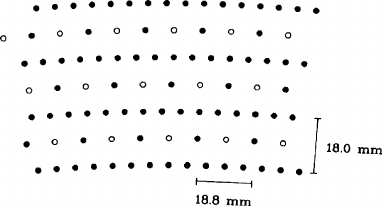
380 11 Existing Drift Chambers – An Overview
It is not unusual that the prototype performed better than the full chamber eventually
did in the experiment.
When the momentum-measurement accuracy actually achieved in an experiment
is compared to that expected from the point-measuring accuracy, the number of
points, and the magnetic field strength (Sect. 8.5.1), it is often not as good as an-
ticipated. The overall mechanical accuracy, local and global field distortions, and
imperfect calibrations all make their contribution to the momentum-measuring ac-
curacy, which sometimes improves only slowly as the apparatus is better and better
understood.
11.5.3 Drift Cells
The minimal wire configuration needed to establish the drift and amplification field
around the proportional wire (which is at a positive potential) is a group of field
wires at a negative potential around it. For a drift chamber of type 2, this elementary
‘cell’ is repeated to fill the whole volume. Figure 11.14 shows, as an example, drift
cells of the ARGUS chamber; the full chamber consists of 5940 cells of this type.
Advantages of this arrangement are the high degree of homogeneity over the full
volume, the fine granularity, which allows the use of single-hit electronics, and the
full track ionization that is employed. On the other hand, the local field around the
wire in one cell is not very homogeneous and thus requires a very careful calibration
of the critical relation between drift time and wire–track distance. In Fig. 11.15 we
see the electron drift paths calculated for such a cell type [HAR 84]. They are in the
form of spirals, created by the B field parallel to the wires. The contours of equal
arrival times are circles near the sense wire, but they are shaped by the field-wire
geometry far from the sense wire. This means in practice that the time–distance
relation for tracks is a function of the orientation of the track with respect to the
drift cell.
The design of the OPAL drift cell goes in the opposite direction (Fig. 11.16).
The basic unit is a wedge-shaped sector that fills 15
◦
of azimuth over the entire
radial space so that the chamber consists of 24 of them. Each sector contains one
radial plane of sense wires which are interspersed by field wires. The sense wires
are actually staggered to resolve the left–right ambiguity. Each sector is limited and
Fig. 11.14 Drift cells of the
ARGUS chamber. The sense
wire is, typically, at 2.9 kV
and the cathode wires are
grounded
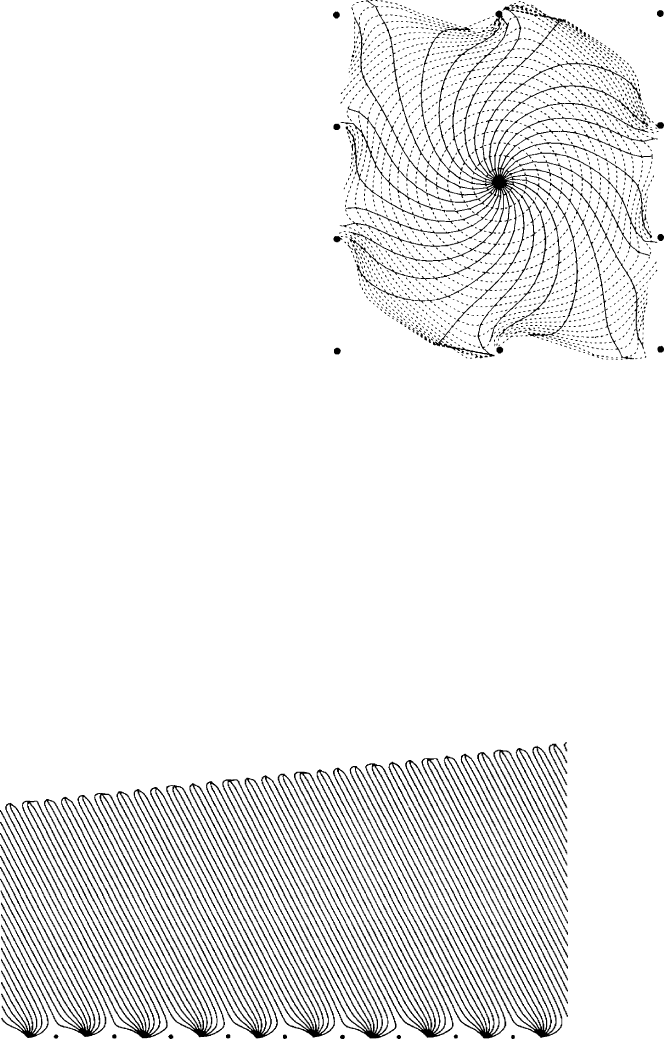
11.5 Large Cylindrical Drift Chambers of Type 2 381
Fig. 11.15 Drift paths and
lines of equal arrival times for
a drift cell of the ARGUS
chamber. The time lines are
15 ns apart
separated from its two neighbours by two common radial planes of cathode wires at
such radially increasing potentials as to create a homogeneous drift field orthogonal
to the central sense/field-wire plane. The inner surface of the enclosing cylinder
carries suitable field degraders. This geometry has also been called ‘jet chamber’
geometry. In this design the homogeneity is constructed into each sector, which is
relatively large. Close tracks are resolved electronically by using short pulses and
digital pulse-shape analysis. The dilemma of the Lorentz angle is diminished by a
high gas pressure and a low magnetic field.
The cell design of the new MARK II chamber follows a similar line: radial
sense/field-wire planes with radial cathode planes in between, but organized in 132
layers, 7.5 cm in radius. This is done in order to be able to create stereo angles in
consecutive layers. There are 972 cells in the chamber. Figure 11.17 shows a cell
with its electron drift trajectories.
Fig. 11.16 A section of the OPAL drift cell with electron drift lines. Upper plane: cathode wires;
lower plane: sense/field wires
